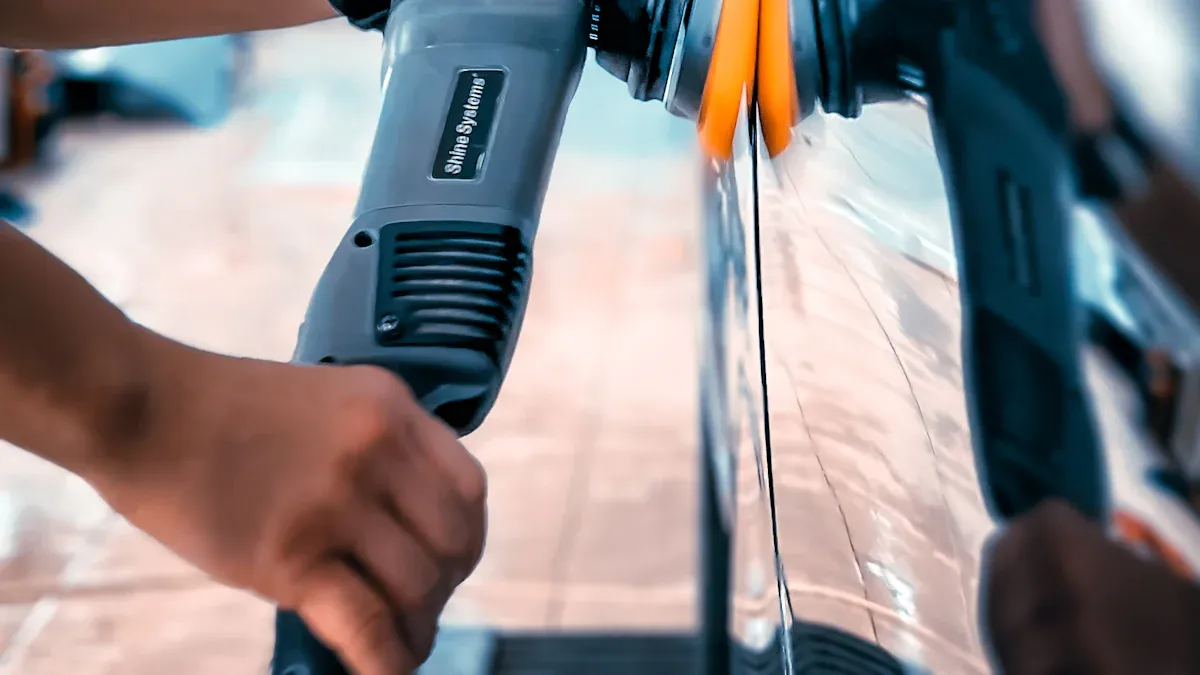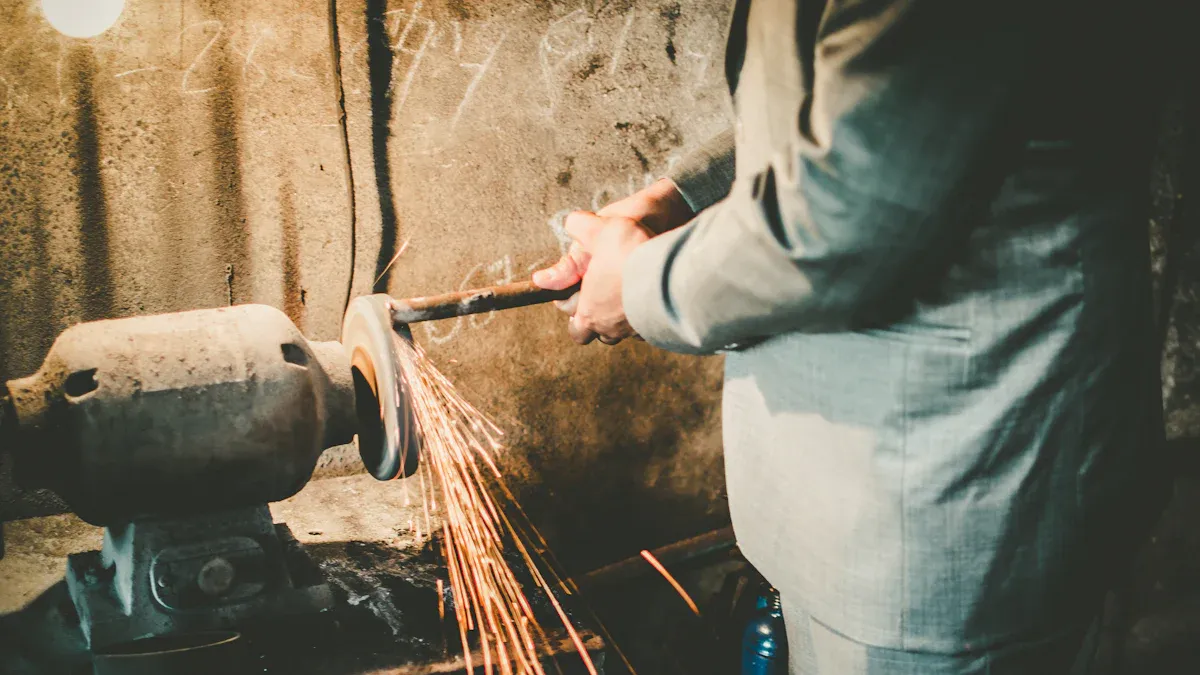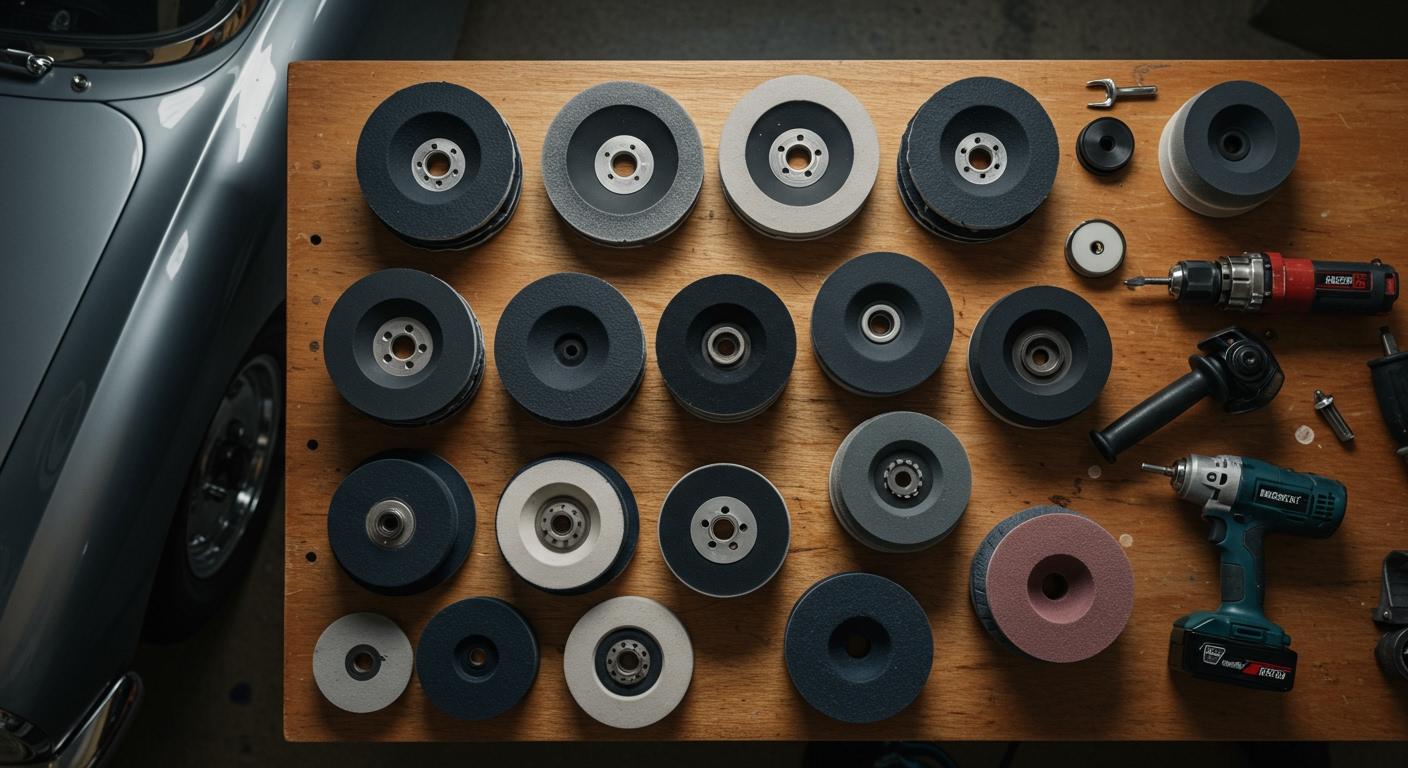Finding the right buffing wheels makes all the difference. For a quick start, we recommend the Aimgrind BD & BK Wheels as Best Overall, the RYOBI Set for DIY projects, and the Zephyr Airway Kit for professionals. You are joining a rapidly expanding market for these essential tools.
| Metric | Value |
|---|---|
| Market Size in 2024 | USD 1.1 Billion |
| Forecasted Growth (CAGR) | 5.1% |
| Market Size in 2034 | USD 1.8 Billion |
This guide will help you select the perfect polishing wheel. You can achieve a flawless mirror finish on any project.
Key Takeaways
- Choose the right polishing wheel material for your task. Sisal wheels are for tough jobs, cotton for general polishing, and felt for delicate work.
- Match your polishing wheel with the correct polishing compound. This helps you get a perfect mirror finish.
- Always use a separate wheel for each type of compound. This stops contamination and gives a better shine.
- Start with a coarse wheel and compound to remove scratches. Then, use finer wheels and compounds for a brilliant mirror finish.
- Clean your buffing wheels regularly with a rake. This removes old compound and metal, making your wheels last longer and work better.
Understanding the Polishing Wheel

Choosing the right polishing wheel is the first step toward a professional result. You need to understand the materials, construction, and compounds. This knowledge helps you select the best buffing products for your project.
Key Materials: Cotton, Sisal, and Felt
Different materials handle different jobs. You should match the wheel material to your task for the best outcome. Sisal, cotton, and felt are three common materials for buffing wheels.
| Wheel Type | Primary Application |
|---|---|
| Sisal Wheels | Aggressive cutting and heavy-duty tasks |
| Cotton Wheels | General polishing and finishing |
| Felt Wheels | Delicate and precise polishing |
Sisal wheels use stiff fibers from the agave plant. They are perfect for the first cutting step on hard metals like steel. Felt wheels use dense wool. They give you great control for a high-quality finish on delicate jobs without removing too much material.
Wheel Construction Types and Uses
The way buffing wheels are made affects their performance. The construction determines how aggressive or soft the wheel is.
- Spiral-sewn wheels have stitches in a spiral pattern. This stitching makes the wheel harder and more aggressive. You can use them for cutting and coarse buffing.
- Loose cotton wheels have only one circle of stitching around the center. They are much softer and more flexible. You should use these for the final buffing stage to achieve a bright shine.
Pairing Wheels with Polishing Compounds
You must pair your wheel with the correct polishing compounds. This combination is key to achieving a perfect mirror finish. Using the wrong compound can ruin your workpiece. The right buffing compounds work with specific polishing products to bring out the best shine.
💡 Pro Tip: Always use a separate wheel for each type of compound to avoid contamination.
The chart below guides you on pairing materials with the right compounds.
| Materials | Step 1: Rough Compound | Step 2: Intermediate Compound | Step 3: Final Compound |
|---|---|---|---|
| Hard Metals | Emery on a Sisal Buff | Stainless on a Spiral Buff | White Rouge on a Loose Buff |
| Soft Metals | Tripoli on a Spiral Buff | — | White Rouge on a Loose Buff |
| Plastics | Jewelers Rouge on a Loose Buff | — | Jewelers Rouge on a Flannel Buff |
Top 10 Buffing Wheels and Polishing Wheels
Now you know the basics. Let’s explore the top 10 buffing wheels on the market. This list will help you find the perfect tool for any project, from a quick DIY touch-up to a professional-grade mirror finish.
Aimgrind BD & BK Polishing Wheels
Best For: Industrial applications and achieving a flawless finish on glass and metal.
Key Specifications: Aimgrind offers extensive customization for its professional-grade polishing wheel. You can select the perfect size for your machinery.
| Type | OD (mm) | T (mm) | ID (mm) |
|---|---|---|---|
| Flat Shape BK | 100 – 250 | 15 – 30 | 22 – 90 |
| Cup Shape BK | 130 – 150 | 30 – 40 | 22 – 70 |
Pros:
- You get superior elasticity for an excellent polishing effect.
- These wheels have a very long lifespan, often lasting twice as long as competitors.
- They adapt well to surfaces, which helps prevent polishing errors on edges.
Cons:
- These professional-grade wheels are designed for industrial machinery and may not be suitable for standard bench grinders.
RYOBI 6-Inch Buffing Wheel Set
Best For: General purpose DIY projects and polishing various metals.
Key Specifications:
- Material: Cotton
- Diameter: 6 inches
- Arbor Size: 1/2 inch
Pros:
- You will find this set is very cost-effective and offers great value.
- The 6-inch size is ideal for covering larger surfaces efficiently.
- It is a durable option that shows minimal wear even after heavy use.
Cons:
- The arbor hole can be a tight fit on some Ryobi bench grinders.
LINE10 Tools 6-Inch Polishing Wheel Kit
Best For: Beginners looking for a complete starter kit.
Key Specifications:
- Material: Cotton (Spiral Sewn and Loose)
- Diameter: 6 inches
- Arbor Size: 1/2 inch
Pros:
- This kit includes multiple buffing wheels and different buffing compounds.
- It provides all the essential buffing products you need to start immediately.
- The instructions are clear and easy for new users to follow.
Cons:
- The included buffing compounds are small and may be used up quickly.
Zephyr Super Shine 8-Inch Airway Buffing Kit
Best For: Professionals and serious hobbyists polishing aluminum.
Key Specifications:
- Material: Cotton (Airway Design)
- Diameter: 8 inches
- Arbor Size: 5/8 inch (for 7-inch angle grinders)
Pros:
- The airway design helps the buffing wheels run cooler, protecting your workpiece.
- This kit includes three wheels and compounds for a complete cut, color, and finish process.
- It comes with safety flanges, making it ready to use on an angle grinder.
Cons:
- This is a professional system and may be overkill for small, occasional projects.
Eastwood 4-Inch Spiral Sewn Buffing Wheel
Best For: Working on small or delicate metal parts.
Key Specifications:
- Material: Cloth with ABS Plastic Hub
- Diameter: 4.5 inches
- Arbor Size: Fits 3/4 inch Keyed Shaft
Pros:
- The spiral-sewn design makes it firm enough for effective cutting with the right polishing compounds.
- Its smaller size gives you excellent control for buffing intricate areas.
Cons:
- This wheel runs hotter than ventilated or airway buffing wheels.
- It cuts slower than larger, more aggressive wheels.
Dura-Gold Pro Series Muslin Buffing Wheels
Best For: Final finishing on soft metals and plastics.
Key Specifications:
- Material: Muslin Cotton
- Diameter: 6 inches
- Arbor Size: 1/2 inch
Pros:
- These high-quality buffing wheels are extremely soft, perfect for the final gloss.
- The high-thread-count muslin holds compound well.
- You can stack multiple wheels to create a wider buffing surface.
Cons:
- They are not suitable for aggressive cutting or removing deep scratches.
- The loose stitching can fray if used at excessively high speeds.
WEN 6-Inch Wool Polishing Bonnet
Best For: Applying wax or polish to vehicles and large surfaces.
Key Specifications:
- Material: Wool
- Diameter: 6 inches
- Arbor Size: Bonnet-style fit for orbital polishers.
Pros:
- The wool material distributes wax evenly and efficiently.
- It is gentle enough for clear coats and sensitive paint jobs.
- You can easily wash and reuse it multiple times.
Cons:
- It is designed for polishers, not bench grinders.
- Wool can leave behind lint if not properly cared for.
3M Perfect-It Wool Compounding Pad
Best For: Aggressive paint correction and scratch removal on automotive finishes.
Key Specifications:
- Material: 100% Wool
- Diameter: 9 inches
- Arbor Size: Quick Connect attachment
Pros:
- This pad offers a very fast cut to remove P1200 and finer sand scratches.
- It stays cooler than foam pads, reducing the risk of burning the paint.
- The pad glides smoothly over surfaces without jumping, giving you better control.
Cons:
- You need to spur the wool fibers regularly to maintain performance.
Dico Products 4-Inch Sisal Buffing Wheel
Best For: Heavy-duty cutting and removing deep scratches from hard metals.
Key Specifications:
- Material: Sisal Fiber
- Diameter: 4 inches
- Arbor Size: 1/2 inch
Pros:
- Sisal is extremely aggressive and works quickly on steel and iron.
- It pairs perfectly with emery or other coarse buffing compounds for rapid material removal.
- The small diameter is great for powerful bench-top motors.
Cons:
- This wheel is too harsh for soft metals like aluminum or for final finishing.
Forney 7-Inch Single-Stitch Buffing Wheel
Best For: Achieving a mirror finish on delicate surfaces.
Key Specifications:
- Material: Cotton
- Diameter: 7 inches
- Arbor Size: 5/8 inch
Pros:
- The single-stitch design makes it very soft and flexible.
- It is one of the best polishing products for applying final-stage polishing compounds.
- The larger diameter helps you cover more area when achieving a mirror finish.
Cons:
- It is not designed for cutting and will wear out quickly if used with coarse compounds.
💡 Quick Tip: Many brands offer buffing wheel and compound kits. These kits are a great way to get started because they provide matched wheels and compounds for a complete polishing system.
A Closer Look at Aimgrind Polishing Solutions
When standard options do not meet your needs, you need a specialist. Aimgrind is an expert in customized abrasive solutions. The brand follows its slogan, “Grind with Passion, Achieve with Aim,” to deliver exceptional results for demanding industries.
Custom Solutions for Industry
Aimgrind offers more than just off-the-shelf products. They provide a complete service to ensure you get the perfect tool for your job. The process includes:
- Problem Diagnosis: Experts analyze your specific polishing challenges.
- Parameter Matching: They match the wheel’s specifications to your equipment.
- Sample Optimization: You receive and test samples to guarantee perfect performance.
This partnership approach makes Aimgrind a valuable asset for any professional operation. You get a solution tailored exactly to your needs.
The Aimgrind Advantage
You gain several key benefits when you choose Aimgrind’s buffing wheels. Their innovative design helps dissipate heat, which protects your workpiece from damage during long polishing sessions. These wheels are also incredibly durable and versatile. You can use them on both glass and metal to achieve a flawless mirror finish. Their superior elasticity allows the polishing wheel to conform to surfaces, preventing errors and ensuring consistent quality.
Aimgrind’s comprehensive service and advanced buffing products help you achieve a professional mirror finish with greater efficiency and reliability.
Product Range Overview
Aimgrind provides a wide selection of buffing wheels and related tools. Their range includes the BD and BK wheels mentioned earlier, which are ideal for industrial applications. You can find the right wheel and matching buffing compounds for every stage of your process. This complete system helps you move from initial cutting to the final high-gloss shine.
Explore their full catalog of solutions to find the perfect tools for your next project. You can view their entire collection on the Aimgrind Polishing Wheels page.
How to Use and Maintain Your Wheels

Using your polishing tools correctly ensures safety and delivers professional results. You can extend the life of your buffing wheels with proper care. This guide will show you how to mount, use, and maintain your equipment.
Proper Mounting and Speed (RPM)
Safety is your top priority when working with grinders. A wheel failure can be extremely dangerous. You must follow safety rules to prevent injury.
- Always inspect new buffing wheels for damage before you mount them.
- Ensure the machine’s speed (RPM) does not exceed the wheel’s maximum rating.
- Keep safety guards in place. The gap between the guard and wheel should be no more than 1/4-inch.
- Wear a respirator and a full face shield. Buffing creates fine dust and can launch parts at high speed.
- Never wear loose clothing, gloves, or jewelry that could get caught in the machine.
Applying Compound Correctly
You apply compound to a spinning wheel. Hold the compound bar against the lower quadrant of the wheel for a few seconds. Do not press too hard. You only need a small amount of polishing compounds to work effectively.
💡 Pro Tip: Use a separate wheel for each type of compound. Mixing buffing compounds will contaminate your workpiece and ruin your mirror finish.
Techniques for a Mirror Finish
Achieving a mirror finish is a step-by-step process. You move from a coarse abrasive to a fine one. This method works well for stainless steel and is a great approach for polishing aluminum.
- Cutting: Start with a sisal or spiral-sewn wheel and a coarse compound to remove deep scratches.
- Intermediate Buffing: Switch to a new wheel and a medium compound, like tripoli. This step refines the surface and improves color. When polishing aluminum, this stage is crucial for smoothness.
- Final Polish: Use a soft, loose cotton wheel with a fine rouge. Apply light pressure to bring out a brilliant shine. This final step is key to achieving a mirror finish.
Cleaning and Raking for Longevity
Your buffing wheels will get clogged with dried compound and metal residue. You should clean them regularly. Use a wheel rake or a piece of scrap metal with a sharp edge. Hold it firmly against the spinning wheel to remove the buildup. A clean wheel cuts faster and lasts longer. Regular cleaning is essential for your equipment’s longevity and performance.
For overall performance, you can trust the Aimgrind wheels. Their versatility and high user satisfaction make them an excellent choice for many projects.
Remember, the secret to a flawless finish is a systematic approach. You must start with the right wheel and compound for your material. Then, you work your way up to a finer grit for that final shine.
This process is the best way to achieve a perfect mirror finish.
What is your go-to polishing wheel for tough jobs? Share your favorites in the comments below! 👇
FAQ
Can I use one wheel for all polishing steps?
You should use a separate wheel for each type of compound. This practice prevents coarse grits from mixing with fine grits. Using a single wheel contaminates your workpiece. It will prevent you from achieving a true mirror finish.
What speed should I run my polishing wheel at?
You must always check the wheel’s maximum RPM (Revolutions Per Minute) rating. Your grinder’s speed should never go above this number. Running a wheel too fast is extremely dangerous. It can cause the wheel to break apart during use.
How do I know when to clean my wheel?
You will notice the wheel stops cutting effectively. Its surface may look glazed, hard, or shiny from buildup. This tells you it is time to clean the wheel with a rake. A clean wheel performs better and lasts longer.
Can I wash my buffing wheels?
Yes, you can wash many cotton and wool wheels.
💡 Tip: Use warm water and a mild detergent. Make sure the wheel is completely dry before you mount it on your machine again. Always check the manufacturer’s care instructions first.
See Also
Selecting Optimal Bench Grinding Wheel Materials for Specific Applications
Picking the Perfect Metal Grinding Wheel for Your Specific Project
Finding the Ideal Grinding Wheel Dresser for Your Workshop
Discovering the Best Crankshaft Grinding Wheel Within Your Budget
Selecting the Premier Grinding Wheel for Your Carbide Tooling
Contact Us
For More Grinding Solution or Customized Abrasive Tools

